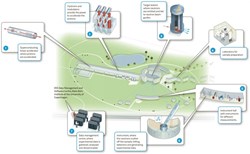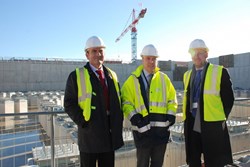ITER NEWSLINE
254
Reshaping the landscape of neutrons
Sabina Griffith
Reshaping the landscape of neutrons

Thirty times more powerful than existing facilities and designed to operate in long pulses, the ESS will act as a kind of super microscope. Source: ESS
Neutrons, along with electrons and X-ray, allow us to see inside matter. Since the wavelength of neutrons is similar to the distance between atoms, they can provide images of structure on an atomic scale. Neutron scattering is therefore an important tool for the provision of structural information on the atomic scale and for the understanding of dynamical properties of solids and liquids.
Quite a number of neutron sources exist around the world, with the most recent newcomer to the club and world leader in the supply of neutrons being the Spallation Neutron Source (SNS) in the US. Now, a new project is about to change the "landscape of neutrons," as Juan Tomás Hernani reported in the most recent Inside ITER seminar last week. Hernani is the Secretary General for Innovation and Industry of the
European Spallation Source (ESS) which is currently under development in southern Sweden. Thirty times more powerful than existing facilities and designed to operate in long pulses, the ESS will act as a kind of super microscope. Metaphorically speaking: if researchers have been studying materials under candlelight so far, the neutrons at ESS will provide the brilliance of floodlight.

Juan Thomás Hernani, ITER Deputy Director-General Carlos Alejaldre and Matti Tiirakari, Director for Administration at ESS, looking at the ITER landscape.
Set up as a joint project of 17 European nations, the ESS at present has reached the critical planning phase for the instruments and components. Construction will begin in 2013 in Lund and the first neutrons together with the initial seven instruments will be available in 2019. The remaining instruments will be completed by 2025, when the facility shall be fully operational. The total costs for planning, construction and operation of ESS are estimated at EUR 1.48 billion.
Click
here to download Juan Tomás Hernani's presentation.
return to Newsline #254



